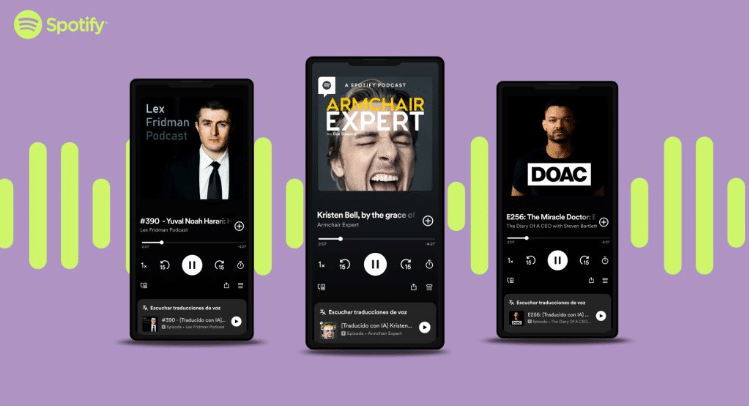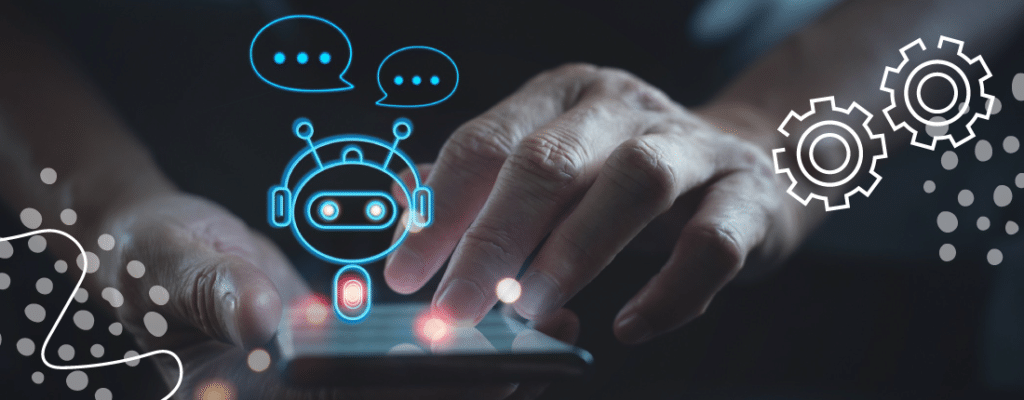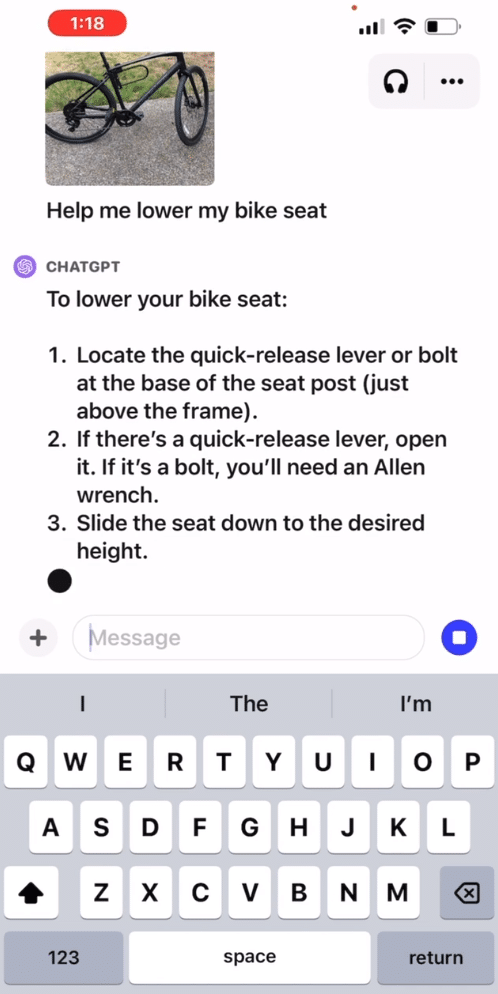There’s no turning back: AI is now an integral part of our reality, and businesses are harnessing its full potential.
According to a survey by Forbes Advisor, companies are currently using or planning to use AI primarily for customer service and cybersecurity.
However, even subjective activities like content production and recruitment have found their place on the list of top AI uses.
Would you have imagined this a decade ago? I certainly wouldn’t have.
Another thing I wouldn’t have pictured is having daily interactions with a language model like ChatGPT.
Despite its imperfections and biases, I’m constantly amazed by its ability to organize information in a way that feels genuinely helpful and human-like.
Now, OpenAI has announced ChatGPT’s new features that allow us to interact with it using voice and images. It makes me wonder: what additional possibilities might the future bring?
ChatGPT’s Voice Feature
Are you a bit startled by the idea of ChatGPT having voice conversations?
Maybe you’ve already gotten used to virtual assistants like Alexa, and talking to a machine doesn’t seem all that strange anymore. That’s exactly what crossed my mind when I read about ChatGPT’s voice conversations.
However, when I listened to some samples provided on OpenAI’s website, it did give me a bit of a spooky feeling.
It’s not because I’m not accustomed to chatting with machines, but because ChatGPT can actually craft engaging stories based on what users say and even sound like Aunt Jane beside my bed.
It reminded me of the intriguing relationship between Theodore and Samantha, an operating system, in the movie ‘Her.’ Could it be that people start falling in love with ChatGPT? Just kidding. Or am I?
What about the risks?
OpenAI appears to be well aware of the potential risks associated with ChatGPT’s voice capabilities, such as impersonation, and they guarantee to have taken steps to address these concerns.
For now, they have limited the use of this technology exclusively to voice chat, and they collaborated with real voice actors for its development. Then, users can choose from five voice options.
However, it raises questions about whether these measures are sufficient to mitigate the risks, especially when considering Spotify’s pilot Voice Translation feature.
This feature mimics the voices of podcasters to translate their content into other languages while retaining their original voices. How powerful (and dangerous) is that?
It’s worth noting that voice cloning tools, which can be used for malicious purposes, are already around, and this issue is not unique to ChatGPT.

ChatGPT’s Image Feature
You know when it’s hard to put something into words, and you have to show someone a picture or a drawing to convey what you mean? Well, ChatGPT has got you covered in those situations as well.
Now you can upload a picture, let’s say of your IKEA furniture, then upload another picture of your toolbox and ask how to assemble it.
You can even draw on the pictures to highlight certain parts for a more specific question! Pretty cool, right?
What you’ll get back is a detailed step-by-step guide on how to use your own tools to assemble that 6-drawer cabinet you’ve always wanted.
Or, it might just say, “It’s IKEA furniture, airhead, it can’t get easier than that!”. Just kidding, ChatGPT is patient and will help you with anything (the perks of being an emotionless machine).
You can even take a picture of your luggage and ask what else you should pack for a 10-day trip to Hawaii, and it’ll provide useful suggestions.
What about the risks?
My first concern when I read about this new ChatGPT feature was the upload of people’s pictures.
Imagine if this is allowed and criminals start using pictures to ask questions like ‘Who’s she?’ or ‘Where can I find her?’
Although nowadays there’s Google Lens for image searches, it wouldn’t enable the location of someone or the acquisition of very personal information.
OpenAI guarantees that its image feature is also limited and doesn’t put anyone at risk. Do you believe that?
I don’t know, I’m a scaredy-cat and wouldn’t upload pictures of my street, apartment interiors, or anyone who matters to me. The outcomes of technology like this are already to be seen, and it’s better to be safe than sorry.
Business Applications of ChatGPT’s New Features
I’ve provided examples of ChatGPT’s new voice and image features for personal use, but what about some business applications?
Let’s explore three potential ways these features can be utilized in a business context.
Enhance customer engagement
You’ve probably come across those stores where you can upload a picture of yourself and receive clothing or makeup suggestions. While not entirely new, they’ve been revolutionary for the customer experience and their perception of the brands.
ChatGPT is following a similar path, revolutionizing how businesses interact with their customers.
Just imagine being able to send a picture of a unique broken product and receiving step-by-step instructions on how to fix it, all without waiting for a technician to come to your house.
This not only saves time but also creates a remarkably positive customer experience.
Promote accessibility and inclusivity
OpenAI seems very proud of its collaboration with Be My Eyes and how it’s making a real difference for people with visual impairments.
Before, blind and low-vision people used the app to contact volunteers who provided visual assistance to them. Now, thanks to Be My AI (Be My Eyes’ AI assistant, powered by GPT-4), they can simply snap a picture and receive an immediate detailed description of it.
But you might be wondering, “What happened to the volunteers?” Well, they’re still around in case users need extra help with descriptions or just prefer that human touch.
This collaboration exemplifies the potential of AI to make the world more inclusive for everyone. It’s not just about technology; it’s about creating a more accessible and empathetic society.
The conversation around AI’s role in enhancing accessibility is promising, and while it’s not the main focus of this article, I encourage everyone to explore this topic further.
Create content and promote products
When it comes to storytelling and marketing, the addition of voice brings a whole new dimension to the table.
Imagine having a captivating voice narrating your brand’s story or conveying intricate product details. It has the potential to create a significantly more engaging and memorable experience for your audience.
Now, let’s talk about ChatGPT’s new image capability. It can also be a valuable asset for crafting compelling stories and generating promotional ideas.
Consider this scenario: If your business operates in the retail sector, you can take a picture of a product release and ask ChatGPT to craft a captivating social media post to promote it or even generate an engaging script for a promotional video.
In the realm of content creation, platforms like Rock Content’s WriterAccess have already begun integrating AI features into their toolkit. I’m confident that ChatGPT’s new image and voice features won’t be left behind.
It’s essential to remember that there’s no need to fear AI replacing humans, as we’ve discussed several times in our blog. Instead, the focus should be on discovering how humans and AI can work in synergy to enhance creativity and productivity.

Final Remarks
It’s pretty clear that ChatGPT’s new features have the potential to be a game-changer, whether you’re using it personally or for your business. However, responsible usage guidelines are not just a legal requirement but a moral imperative.
This includes obtaining proper consent, securing data, and being transparent about how voice and images will be used.
Businesses that prioritize user privacy and ethics in their AI applications build trust with their customers, which is invaluable in today’s data-driven world.
As of now, ChatGPT’s latest voice and image features are exclusive to those who’ve gone premium. But guess what? Regular folks might get a sample for free soon.
Eager to take it for a spin? I am.








